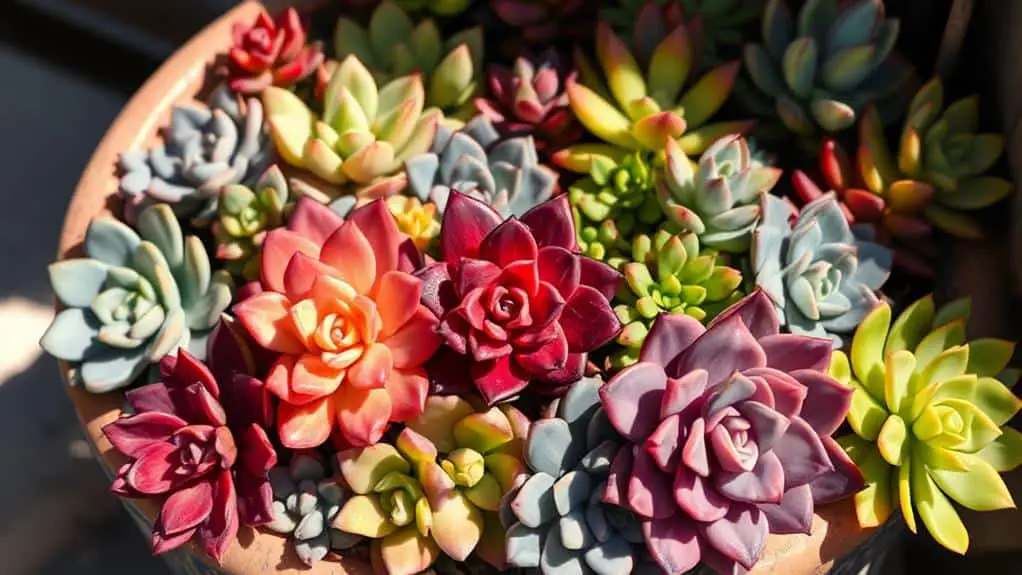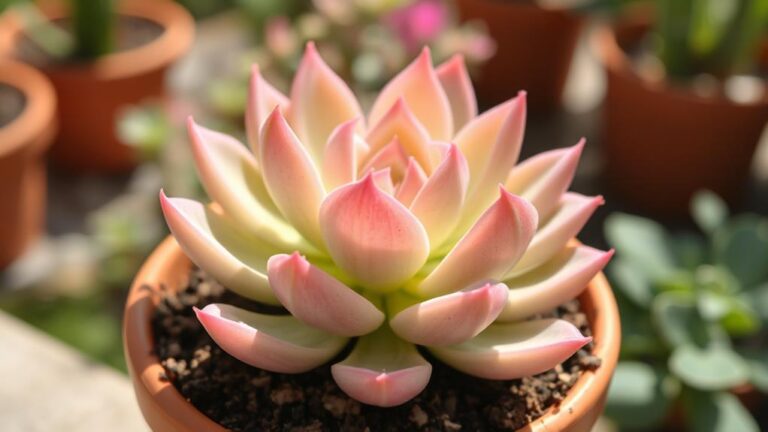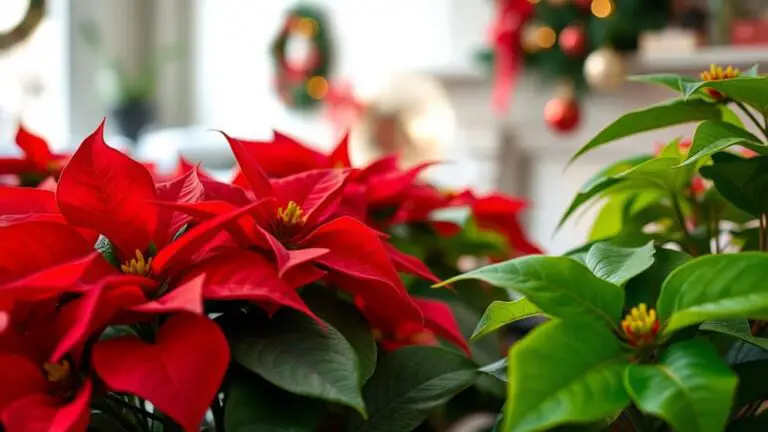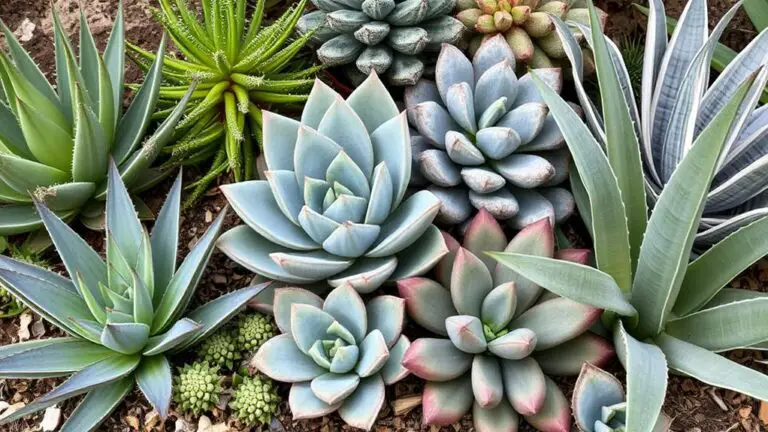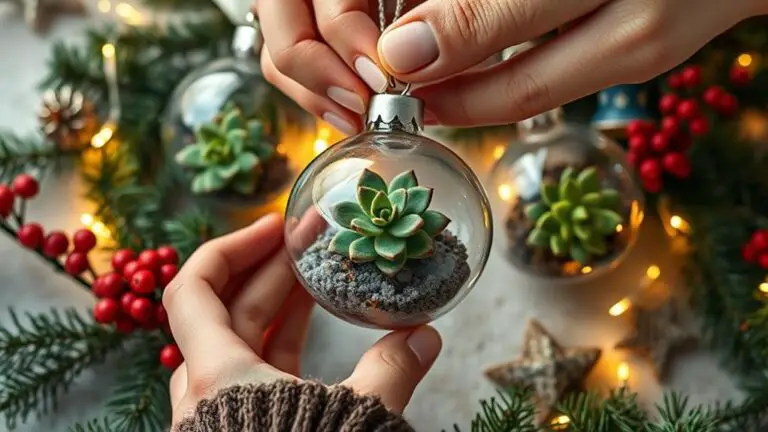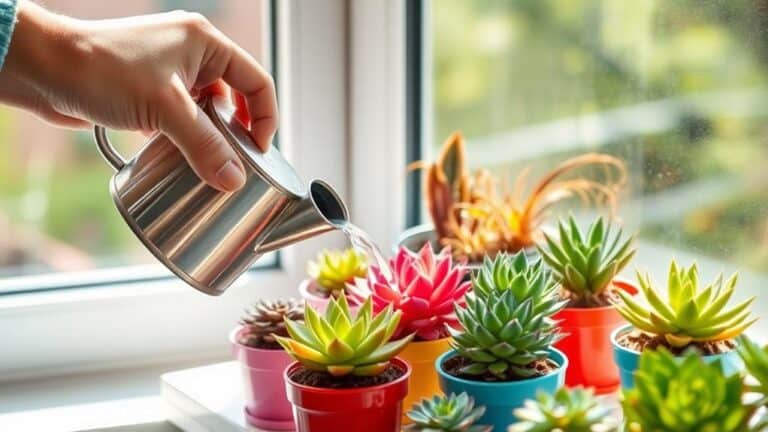What Are Succulents?
When you think about plants that don't need much water, succulents might come to mind. These unique plants store water in their thick, fleshy leaves, stems, or roots, making them perfect for arid environments. But there's more to succulents than just their water-storing capabilities. Have you ever wondered how they manage to survive in extreme conditions or what makes them so diverse in appearance? Understanding their environmental needs and how they adapt might surprise you. What secrets do these resilient plants hold, and how can you care for them to keep them thriving?
Definition and Characteristics
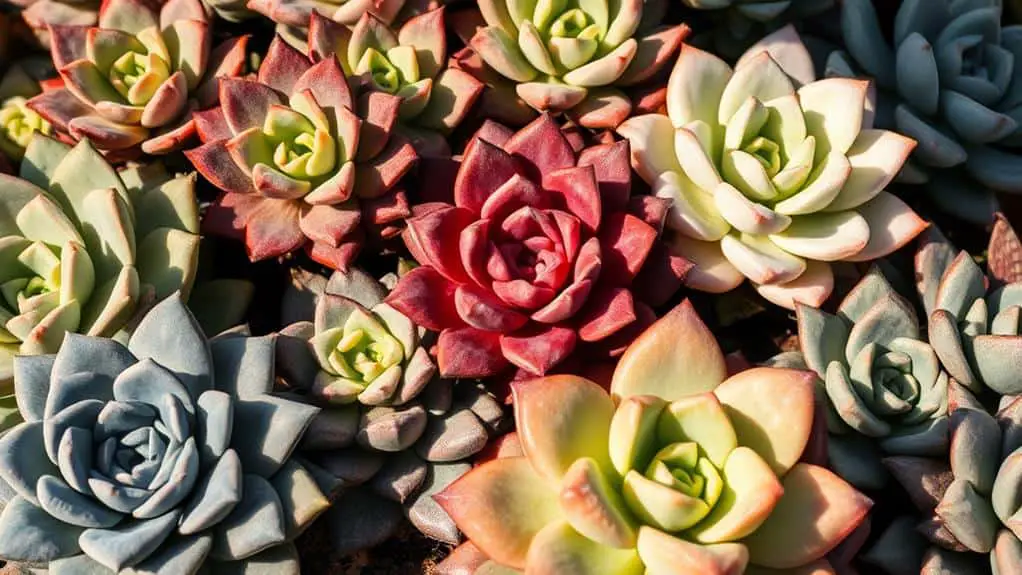
Succulents embody resilience with their thick, fleshy parts designed to store water, making them ideal for arid environments. As a gardener, you'll find succulents fascinating due to their ability to thrive in places where other plants might struggle.
These plants, classified as xerophytes, can endure long periods without moisture because of their unique water-storing tissues. Some species can even survive up to two years without water, depending on the conditions.
When you look at succulents, you'll notice their thick leaves. These leaves aren't just for show; they're crucial for storing water, which is essential in arid environments. In fact, certain succulent organs can hold up to 90-95% water. This makes them perfect for places with minimal rainfall.
Succulents are incredibly diverse, with over 60 plant families containing succulent species. You might recognize names like Echeveria, Sempervivum, and Crassula, each boasting different colors, shapes, and textures.
While all cacti are succulents, they've unique features like areoles and spines that set them apart.
Understanding these characteristics helps you appreciate the hardiness and beauty of succulents, making them a wonderful addition to your gardening adventures.
Temperature and Environmental Needs
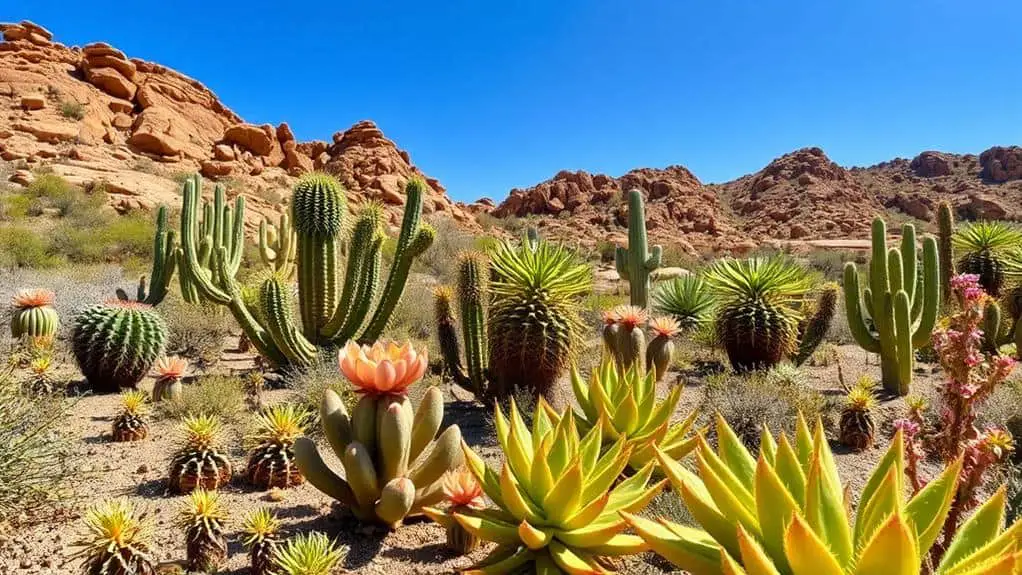
Adapting to the right temperature and environment is essential for your succulents to thrive. Most succulents flourish in warm temperatures between 60°F and 80°F (15°C – 27°C). Freezing conditions can harm or even kill them, so it's important to keep them in a stable environment.
Some species, like certain sedums and sempervivums, can handle colder weather, but it's best to avoid extreme temperature swings to prevent stress and potential color changes.
Succulents prefer low humidity because high humidity levels can lead to root rot and other moisture-related problems. Consequently, it's wise to place them in areas with good air circulation. Bathrooms, which are often humid, aren't ideal spots. Instead, choose locations with consistent temperatures and plenty of airflow.
Sunlight is another significant factor. Succulents need 6-7 hours of indirect sunlight daily to maintain their vibrant colors and promote healthy growth. Without enough light, they may turn a dull green.
To create an ideal environment for your succulents, follow these tips:
- Maintain warm temperatures: Keep them between 60°F and 80°F.
- Promote low humidity: Avoid placing them in humid areas.
- Provide ample sunlight: Aim for 6-7 hours of indirect light daily.
Color Changes and Adaptations
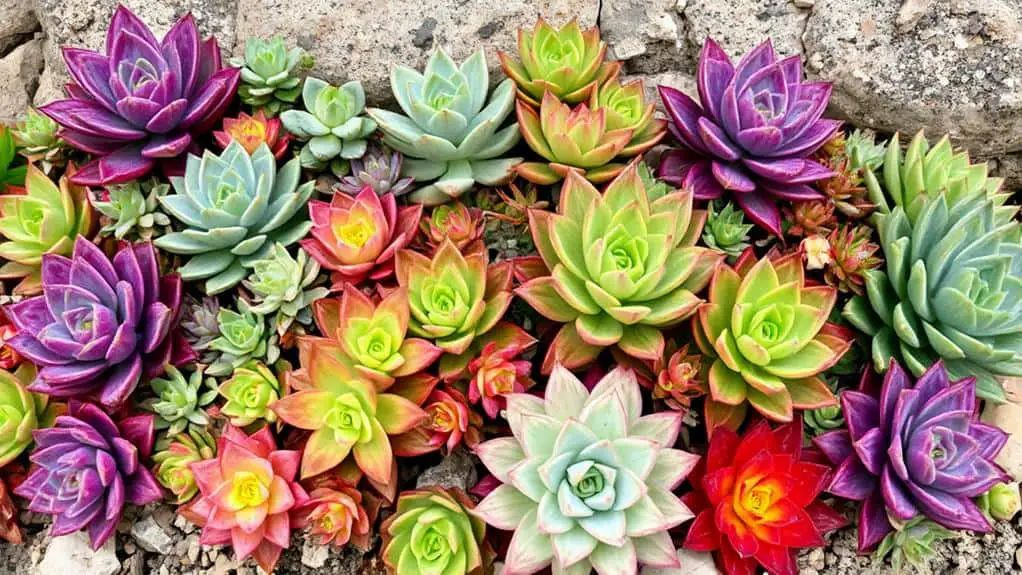
Witnessing the beautiful color transformations in your succulents can be both fascinating and informative. These color changes are more than just pretty; they're a sign of your plant's adaptations. When succulents face environmental stress, like drought or too much sunlight, they may blush into stunning hues of pink, orange, purple, or red.
The vibrancy of these colors is mainly influenced by sunlight. If your succulent isn't getting enough light, it might turn a dull green. Ensuring your plant gets plenty of sunlight helps it show off its true colors.
These changes aren't just for looks; they help succulents conserve water and protect themselves from harsh light. Observing these color shifts can also give you clues about your succulent's health. Seasonal changes or stress can trigger unique color patterns, indicating how well your plant is adapting.
Additionally, these vibrant colors can attract pollinators, helping your succulent thrive.
Propagation Abilities
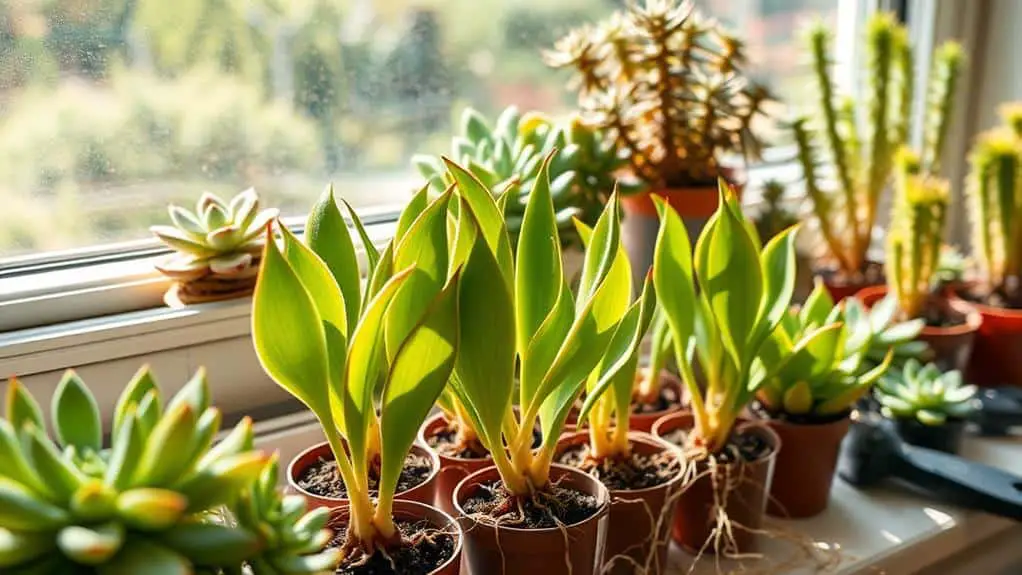
When it comes to propagation abilities, many succulents are truly remarkable. These hardy plants can easily multiply, letting you grow your collection with just a bit of effort.
One of the coolest things about succulents is their ability to propagate from fallen leaves. You can take healthy leaf cuttings, let them callous over, and then plant them to grow new plants. This process helps prevent rot and guarantees healthy growth.
Another way succulents propagate is through "pups" or offsets. As some succulent species mature, they produce these little clones that can be separated and replanted. This method is super easy and a great way to share your plants with friends.
Here are three popular methods for succulent propagation:
- Leaf Cuttings: Simply take a healthy leaf, let it callous, and plant it.
- Stem Cuttings: Cut a piece of the stem, let it dry, and then plant it for new growth.
- Pups/Offsets: Separate these mini plants from the parent and replant them.
Vegetative propagation is a favorite among succulent enthusiasts because it's straightforward and rewarding.
With a little patience, you'll see your garden flourish in no time!
Diversity and Classification
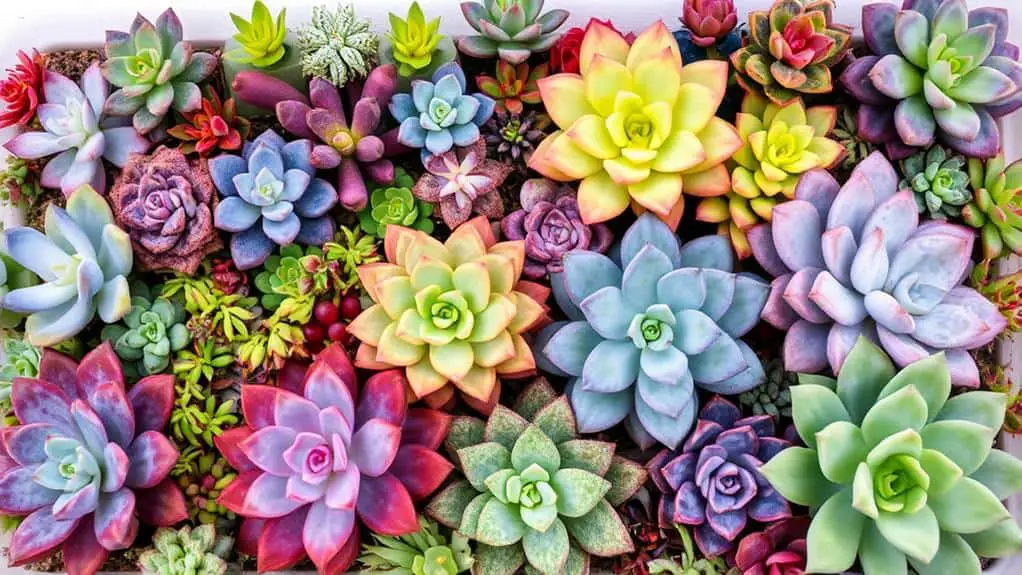
Succulents are incredibly diverse, spanning over 60 plant families like Cactaceae and Crassulaceae.
You'll find that cacti stand out due to their special features, such as areoles, which make them unique among succulents.
With a broad range of colors, shapes, and textures, succulents like Echeveria and Senecio Rowleyanus offer endless possibilities for your collection.
Succulent Families Overview
Understanding the diversity and classification of succulents reveals a fascinating world of plant families that thrive in arid conditions. Succulent plants are incredibly diverse, belonging to over 60 different families. Some of the most notable families include Cactaceae, Agavoideae, Aizoaceae, and Crassulaceae. Each of these families offers unique characteristics and species that make them stand out.
- Cactaceae: This family includes the well-known cacti, which are often treated separately due to their distinctive areoles and spines. They're primarily found in the Americas.
- Agavoideae: Known for their rosette growth form, plants in this family, like agaves, are often seen in desert landscapes.
- Aizoaceae: These are primarily found in South Africa and are known for their vibrant, daisy-like flowers.
South Africa is a significant hotspot for succulents, home to about one-third of all species. This hints at the global distribution and ecological importance of these plants.
Curiously, some genera like Euphorbia and Crassula include both succulent and non-succulent species, showcasing their versatility.
When you're classifying succulents, remember that horticultural practices might sometimes differ from scientific definitions.
Genera and Species Variety
Exploring the genera and species variety within succulents reveals a rich tapestry of plant diversity. Succulents encompass a wide range of genera and species, spanning over 60 plant families. Significantly, the Cactaceae family is a prominent member, along with Crassulaceae and Aizoaceae. Each family brings its unique charm to the succulent world.
You'll find fascinating genera such as Echeveria, which is famous for its beautiful rosette-shaped leaves. On the other hand, Sedum boasts diverse forms and growth habits, making it a favorite among gardeners.
While cacti are classified as succulents, they often get special attention due to their unique traits, like areoles, which are specialized structures for spine and leaf emergence.
It's also intriguing to observe that some succulent species have semi-succulent characteristics, making classification a bit fuzzy. This just adds to the incredible diversity within the succulent category.
South Africa is a hotspot for these plants, home to about one-third of the world's succulent species, showcasing their global diversity and ecological importance.
Understanding these plant families, genera, and species will help you appreciate the variety and adaptability of succulents. Immerse yourself, explore, and enjoy the world of these amazing plants!
Habitat and Distribution
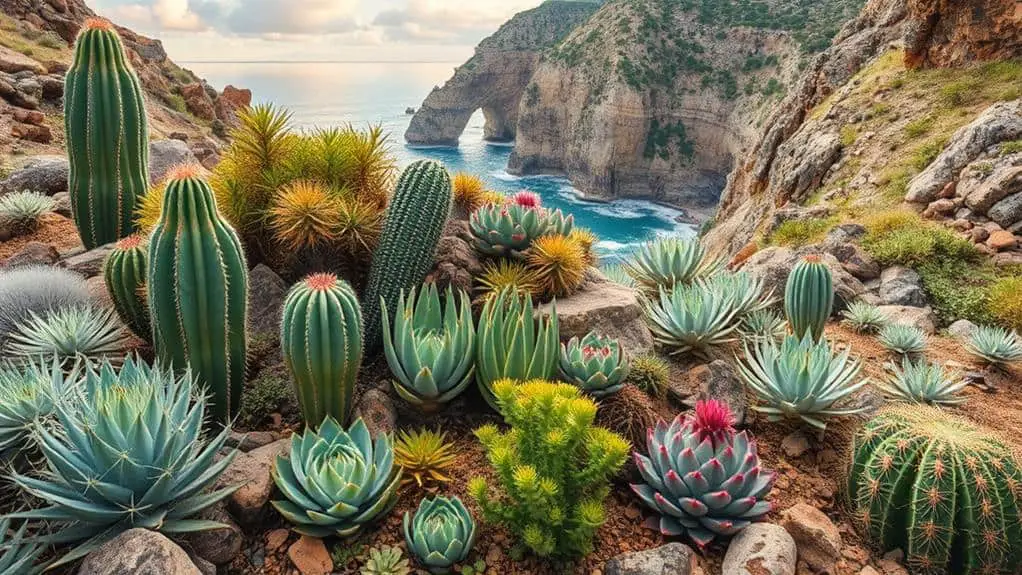
You'll find succulents in almost every corner of the world, except Antarctica.
They thrive in all kinds of places, especially rocky soils and coastal areas where other plants might struggle.
South Africa and California are two regions where these resilient plants are particularly abundant, showcasing their ability to adapt to arid climates and high mineral environments.
Global Distribution Patterns
Succulents thrive in a remarkable range of habitats across the globe, except for the frigid continent of Antarctica. Their adaptability allows them to flourish in rocky soils and coastal areas that many other plants find inhospitable.
You can find these resilient plants in diverse locations, showcasing their incredible ability to survive in challenging conditions.
Key Global Distribution Facts:
- South Africa: One-third of all succulent species are native to South Africa. However, these species face significant extinction risks due to poaching and mining activities. Conservation efforts are vital to protect these unique plants.
- California: Nearly a hundred native succulent species call California home. They're primarily found in coastal areas, thriving in the state's unique climate and soil conditions.
- High Mineral Environments: Many succulents flourish in high mineral environments, which are typically unsuitable for other plants. This adaptability highlights their remarkable ability to survive where others cannot.
The global demand for succulents, particularly in Asian markets, has increased conservation challenges.
It's important to promote sustainable practices in the trade to guarantee these fascinating plants continue to thrive. By understanding their global distribution and conservation needs, you can better appreciate and help protect these extraordinary plants.
Preferred Growth Environments
Understanding where succulents thrive helps us appreciate their unique adaptations and resilience. These plants are masters of survival, flourishing in dry, arid climates where other plants would struggle. Succulents can be found in diverse habitats around the world, from rocky soils to coastal areas. They've evolved to store water in their leaves, stems, or roots, making them perfect for dry environments.
In South Africa, about one-third of all succulent species call this region home. They thrive despite the threats of poaching and mining. If you're growing succulents, you'll be interested to know that California is also a hotspot, with nearly a hundred native species mostly found in coastal regions. This shows how adaptable succulents are to various climates.
These plants can even flourish in high mineral environments, which are unsuitable for most other plants. This resilience highlights their specialized adaptations and ability to thrive in challenging conditions.
What's more, succulents are distributed across all continents except Antarctica, demonstrating their incredible ability to survive a wide range of ecological conditions.
Conservation Issues and Trade

The illegal trade of cacti and succulents poses a significant threat to biodiversity, especially in regions like South Africa where many endemic species face extinction due to poaching and habitat destruction. You might be surprised to learn that high demand for succulents in Asian markets has worsened this problem. Some rare species are being harvested right from their natural habitats, making conservation efforts even more critical.
To understand the impact and what can be done, consider these points:
- Illegal Trade: The black market for succulents is flourishing, driven by collectors who don't realize the damage they're causing.
- Habitat Destruction: When poachers remove plants from the wild, they often destroy the surrounding environment, harming other species too.
- Sustainable Practices: Supporting organizations like the Cactus and Succulent Society of America can help. They promote responsible trading and educate the public on how to protect threatened populations.
Since 1974, South Africa has had legal protections for certain succulent species, but they're not enough on their own.
We need ongoing conservation efforts to prevent further loss. By raising awareness and supporting sustainable practices, you can help protect these amazing plants.
Light Requirements

Getting the right amount of light is essential for your succulents to thrive. Succulents need about six hours of sunlight every day. While they love the sun, too much direct sunlight can actually harm them. A spot with bright, indirect sunlight is perfect. You can use sheer curtains to filter harsh rays and provide just the right amount of light.
Most succulents won't do well in full shade. If they don't get enough light, you might notice them leaning toward the light source or their colors becoming dull. To keep your succulents looking their best, rotate them weekly. This helps them grow evenly and keeps them from becoming lopsided.
Be careful with too much direct sunlight, as it can cause leaf burn. If you see any signs of this, move your plants to a spot with more indirect light.
Grouping your succulents together can also help create a microclimate with the right light and humidity levels for healthy growth.
Watering Practices
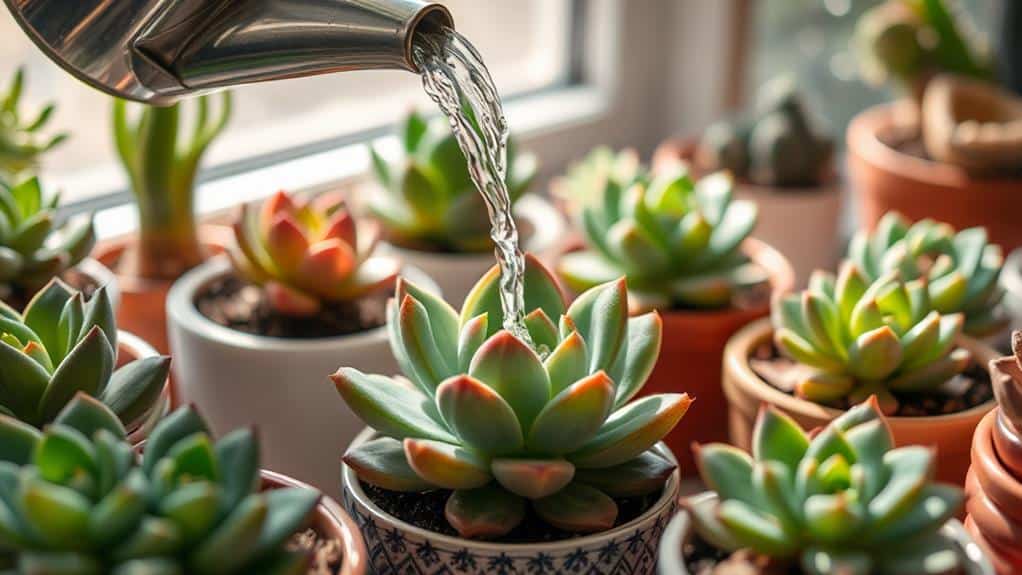
Watering practices for succulents often trip up even the most attentive plant lovers. These hardy plants thrive in dry conditions, but they're sensitive to over-watering. Here's how to keep your succulents happy and healthy.
First, always let the soil dry out completely between waterings. Touch the soil; it should be dry at least 1.25 inches down before you water again. This prevents waterlogged soil, which can lead to root rot.
Second, use the "soak and dry" method. Soak the soil thoroughly until water drains from the bottom. Then, let it dry out completely before the next watering. This mimics their natural desert environment.
Third, use room temperature water to avoid shocking your plants. During growth phases in spring and summer, check moisture levels more frequently. Succulents might need more water as they grow.
Look for signs of thirst, like shriveled or puckered leaves. These signs mean it's time to water. Remember, over-watering is a common mistake, so it's better to err on the side of dryness.
Frequently Asked Questions
What Makes a Plant a Succulent?
To identify a succulent, look for thick, fleshy leaves or stems designed to store water. These plants thrive in arid environments, relying on their water-storing tissues to survive long periods without moisture. They're true xerophytes.
Do Succulents Have a Purpose?
Yes, succulents have multiple purposes. They stabilize soil, prevent erosion, and improve air quality. They're great for drought-prone gardens, offer medicinal benefits, like Aloe Vera, and some even produce nutritious, edible fruits.
Are Cactus and Succulent the Same?
Cacti and succulents aren't the same. While all cacti are succulents due to their water-storing abilities, not all succulents are cacti. Cacti have unique areoles and spines, whereas other succulents have varied leaf shapes and textures.
Do Succulents Need Sun or Water?
Succulents need both sun and water. They thrive with about six hours of bright, indirect sunlight daily. Water your succulents only when the top 1.25 inches of soil is dry, using the "soak and dry" method.
Conclusion
Caring for succulents isn't as hard as it seems. With the right light, temperature, and watering, you'll see them thrive in no time. Remember, these plants are tough and can adapt well to different environments. Don't worry if you make mistakes; it's all part of the learning process. Just keep experimenting and enjoying the journey. You'll soon find that your succulents are not just surviving, but flourishing beautifully. Happy gardening!

